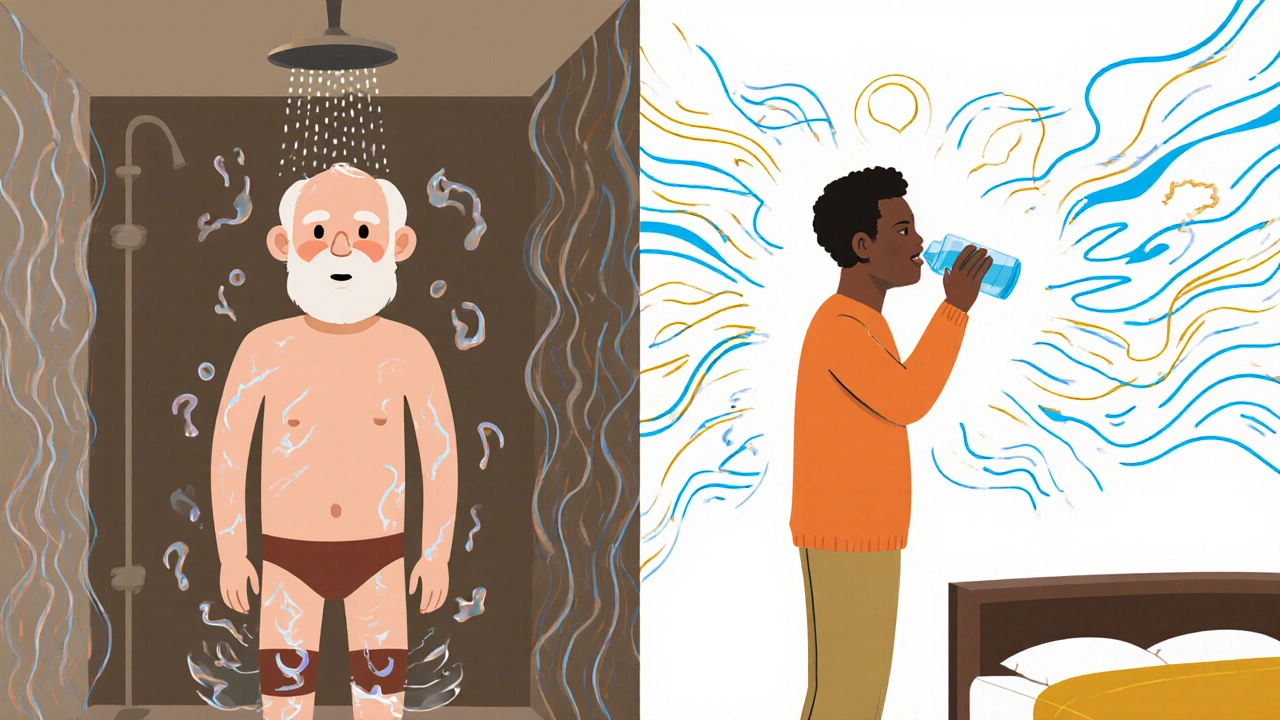Blood Pressure Medication Safety in Older Adults: How to Reduce Orthostatic Hypotension Risks

When you're over 65 and taking blood pressure medicine, standing up too fast can make you dizzy-or worse, fall. It’s not just aging. It’s often the medicine itself. Orthostatic hypotension, a sudden drop in blood pressure when standing, affects 3% to 26% of older adults on antihypertensives. That’s millions of people in the U.S. alone. And yet, many doctors still think lowering blood pressure too much causes this. The truth? It’s often the type of drug, not the intensity, that’s the problem.
Why Standing Up Can Be Dangerous
When you stand, gravity pulls blood down into your legs. Healthy bodies respond by tightening blood vessels and speeding up the heart to keep blood flowing to the brain. But in older adults, that reflex weakens. The baroreceptors-your body’s pressure sensors-don’t react as fast. Blood pressure drops. Dizziness, blurred vision, or fainting follow. In severe cases, it leads to falls, fractures, or hospital stays. The scary part? This isn’t just about being old. It’s about what’s in your medicine cabinet. Certain blood pressure drugs make this worse. Others? They might actually help prevent it.Which Medications Are Riskiest?
Not all blood pressure pills are created equal when it comes to orthostatic hypotension. Some carry a much higher risk, especially in seniors.- Alpha blockers (like doxazosin, terazosin): These have the highest risk-up to 28% of older adults on them experience orthostatic hypotension. They’re often prescribed for prostate issues, but the trade-off can be dangerous.
- Beta-blockers (like metoprolol, atenolol): These slow the heart rate and reduce the body’s ability to compensate when standing. Studies show they increase the risk of sustained low blood pressure by over 3 times.
- Diuretics (like hydrochlorothiazide): By flushing out fluid, they can leave you volume-depleted. That makes standing up feel like stepping off a cliff.
- Central sympatholytics (like clonidine): These suppress the nervous system’s ability to raise blood pressure when needed. High risk, low reward in older adults.
On the flip side, some drugs are safer-or even protective.
- ACE inhibitors (like lisinopril) and ARBs (like losartan): These show the lowest risk. In fact, multiple studies found they reduce orthostatic hypotension by 14-15% compared to other classes. They’re now the go-to first choice for seniors.
- Amlodipine and isradipine (calcium channel blockers): These work slowly and gently. Amlodipine may cause mild dizziness in the first few months, but after a year, risk drops to near baseline. Isradipine has the lowest OH risk among all dihydropyridine CCBs-just 5.2% in elderly trials.
Here’s the twist: taking your blood pressure lower doesn’t automatically make you more likely to faint. The landmark SPRINT trial showed that older adults aiming for a systolic pressure under 120 mm Hg had no higher rate of orthostatic hypotension than those targeting 140 mm Hg. In fact, aggressive treatment reduced OH risk by 17%. The old belief-that lowering BP too much causes dizziness-is wrong. The problem isn’t the number. It’s the drug.
What to Do If You’re Already on a Risky Drug
If you’re on an alpha blocker or beta-blocker and you’ve had dizziness when standing, don’t stop cold turkey. Talk to your doctor. A slow switch can make all the difference.- Step 1: Review every pill. Include over-the-counter meds, sleep aids, and antidepressants. SNRIs like venlafaxine can also cause OH. The American Geriatrics Society Beers Criteria flags alpha blockers, certain beta-blockers, and tricyclics as potentially inappropriate for seniors.
- Step 2: Switch to a safer alternative. If you’re on doxazosin, ask about switching to an ARB like losartan. If you’re on metoprolol, consider amlodipine. Studies show 65% of patients report fewer dizzy spells and falls after switching.
- Step 3: Time your doses. If you’re on a short-acting diuretic, take it after breakfast-not before bed. For long-acting meds, take them at night if you have isolated systolic hypertension. This avoids nighttime drops that can worsen morning OH.
It takes 4 to 6 weeks to fully adjust. Monitor your blood pressure both lying down and standing. Do it at home. Write it down. Bring it to your next appointment.

Non-Medication Strategies That Actually Work
Medicine isn’t the only tool. Simple habits can reduce dizziness and prevent falls.- Stand up slowly. Don’t jump out of bed. Sit on the edge for 30 seconds. Then stand still for another 30. Do this three times a day-after waking, after meals, after using the bathroom. Your body learns to adjust.
- Hydrate. Drink 16 oz of water before standing up. It boosts blood volume and helps maintain pressure. One small study showed this cut dizziness by nearly half in older adults.
- Wear compression stockings. These help push blood back up from your legs. Not glamorous, but effective. Look for knee-high, 15-20 mmHg gradient support.
- Avoid heat. Hot showers, saunas, and hot days dilate blood vessels and make OH worse. Keep showers warm, not scalding.
- Elevate the head of your bed. Just 6-10 inches. This reduces nighttime fluid pooling and helps your body maintain better pressure balance in the morning.
Most people see improvement in 2 to 4 weeks with these changes alone. No pills needed.
When Medication for OH Itself Might Be Needed
If you’re still dizzy after switching drugs and making lifestyle changes, your doctor might consider adding a drug specifically for orthostatic hypotension.- Midodrine (Orvaten): A vasoconstrictor that tightens blood vessels. Takes effect in 30 minutes. Lasts 2-4 hours. Avoid taking it after 6 PM-it can cause high blood pressure while lying down.
- Droxidopa (Northera): Converts to norepinephrine, helping your body raise pressure naturally. Used for neurogenic OH, but also helpful in elderly patients with severe symptoms.
- Fludrocortisone: A steroid that helps your body hold onto salt and water. Risk of swelling and heart strain. Use only if other options fail.
- Pyridostigmine (Mestinon): Boosts nerve signals to blood vessels. Less commonly used, but can help in cases where nerve signaling is impaired.
These are not first-line. They’re for when the basics don’t work. And they come with their own side effects. Always weigh risks.

The Bigger Picture: Why This Matters Now
In 2023, over 74 million Americans over 65 had high blood pressure. Roughly 2 to 19 million of them likely have orthostatic hypotension. That’s a huge number of people at risk for falls-the leading cause of injury-related death in seniors. New guidelines from the American Geriatrics Society and the European Society of Cardiology now clearly say: don’t stop effective blood pressure treatment just because someone gets dizzy. Instead, fix the drug. Switch to a safer class. Optimize timing. Use non-drug tools. The future? Drugs that only work when you’re upright. Two compounds are already in Phase II trials. They’ll release their effect only when standing, not when lying down. That’s the goal: control high blood pressure without causing low blood pressure.Right now, you have control. You don’t have to live with dizziness. You don’t have to accept falls as part of aging. Ask your doctor: "Is this the safest medicine for me?" and "Can we try something with less risk?" Your next step might just be a conversation.
Can blood pressure medication cause dizziness when standing?
Yes. Certain blood pressure medications-especially alpha blockers, beta-blockers, and diuretics-can cause orthostatic hypotension, a sudden drop in blood pressure when standing. This leads to dizziness, lightheadedness, or even fainting. It’s not normal aging-it’s often a side effect of the drug. Switching to safer options like ACE inhibitors or ARBs can help.
Should I stop my blood pressure medicine if I feel dizzy?
No. Stopping abruptly can raise your blood pressure dangerously, increasing your risk of stroke or heart attack. Instead, talk to your doctor. They can check if your medication is the cause and switch you to a safer one. Most dizziness can be resolved without stopping treatment.
What’s the safest blood pressure medicine for older adults?
ACE inhibitors (like lisinopril) and ARBs (like losartan) are the safest choices for older adults at risk of orthostatic hypotension. They have the lowest risk of causing dizziness and may even reduce OH episodes. Calcium channel blockers like amlodipine and isradipine are also good options, especially if you have isolated systolic hypertension.
How long does it take to adjust to a new blood pressure medication?
It usually takes 4 to 6 weeks for your body to fully adjust to a new blood pressure medication. During this time, monitor your blood pressure both lying down and standing. Keep a log and report any dizziness or unusual symptoms to your doctor. Lifestyle changes like slow standing and hydration can speed up improvement.
Can lifestyle changes reduce dizziness from blood pressure meds?
Yes. Simple habits make a big difference: stand up slowly, drink 16 oz of water before standing, wear compression stockings, avoid hot showers, and elevate the head of your bed by 6-10 inches. These steps help your body manage blood pressure changes naturally. Most people see improvement within 2 to 4 weeks.
Are there new blood pressure drugs being developed for older adults?
Yes. Two new drugs in Phase II trials are designed to activate only when you stand up-not when you’re lying down. These "smart" medications aim to control high blood pressure without causing dizziness. They could become available within the next 5 years. Until then, the best approach is choosing safer existing drugs and using non-drug strategies.
What to Do Next
If you or someone you care for is over 65 and on blood pressure medication:- Check the pill bottle. Is it an alpha blocker, beta-blocker, or diuretic? If yes, ask about alternatives.
- Start tracking dizziness. When does it happen? After standing? After meals? After medication?
- Begin the slow-stand habit. Sit for 30 seconds, then stand for 30 seconds. Do this three times a day.
- Buy a home blood pressure monitor. Take readings lying down, then standing. Write them down.
- Book a medication review with your doctor. Bring your log. Ask: "Is this the safest option for me?"
You don’t need to live with dizziness. You don’t need to fear standing up. With the right medicine and simple habits, you can stay steady, safe, and in control.
Julie Pulvino
November 23, 2025 AT 15:58Wow, this is the most practical post I’ve read all month. I’ve been dizzy every morning since my doctor put me on doxazosin for prostate stuff-never connected it until now. Just switched to losartan last week and already feel like I can stand up without holding onto the wall. Thank you for laying this out so clearly.